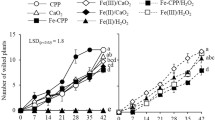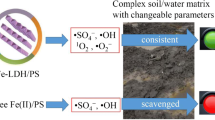Abstract
The transfer of several metal ions from the soil to the plant absorbing cells is mediated principally by organic molecules of low molecular weight with complexing and reducing activity, among which caffeic acid (CAF) is particularly important. Here we report the results of a survey which deals with the oxidation of CAF by the Fe(III) ions bound to a polygalacturonate network (Fe(III)-PGA network). The interaction between Fe(III) and CAF was studied by using Fe(III)-PGA networks equilibrated in the 2.4-7.0 pH range by means of kinetic and spectroscopic methods. The reducing power was found to depend on the nature of the Fe(III)-PGA network complexes: when the ferric ion was complexed only by the PGA carboxylic groups, a high redox activity was observed, whereas the Fe(III) reduction was found to be lower when a hydroxylic group was inserted in the Fe(III) coordination sphere. The iron complexed in the network was protected from hydrolysis reactions, as shown by the high pH values at which its reduction occurred. Two different fractions of Fe(II) produced were identified, one diffusible and another exchangeable with CaCl2 6.0 mM. The existence of the exchangeable form was attributed to the electrostatic interaction of the Fe(II) ions with the carboxylate groups of the fibrils and with the degradation products of CAF. The arrangement of the fibrils was altered following the substitution of Ca(II) by Fe(III) ions and was restored following the reduction of Fe (III) by CAF.
Similar content being viewed by others
References
Brown J C 1969 Agricultural use of synthetic metal chelates. Soil Sci. Soc. Am. Proc. 33, 59-61.
Deiana S, Erre L, Micera G, Piu P and Gessa C 1980 Coordination of transition-metal ions by polygalacturonic acid: a spectroscopic study. Inorg. Chim. Acta 46, 249-253.
Deiana S, Micera G, Muggiolu G, Gessa C and Pusino A 1983 Interaction of transition-metal ions with polygalacturonic acid: a potentiometric study. Colloids Surfaces 6, 17-25.
Deiana S, Gessa C, Solinas V, Piu P and Seeber R 1989 Analytical study of the interactions of D-Galacturonic acid with iron(III) and iron(II) in solution and with iron(III) bentonite. Anal. Chim. Acta 226, 315-322.
Deiana S, Gessa C, Piu P and Seeber R 1991 Iron(III) reduction by D-Galacturonic acid. Part 3. Influence of the presence of additional metal ions and of 2-amino-2-deoxy-D-Gluconic acid. J. Chem. Soc. Dalton Transl. 1237-1241.
Deiana S, Gessa C, Manunza B, Marchetti M and Usai M 1992 Mechanism and stoichiometry of the redox reaction between iron(II) and caffeic acid. Plant Soil 145, 287-294.
Deiana S, Gessa C, Pistidda C, Pilo M I and Seeber R 1995a Redox properties of phenolic compounds of interest in soil chemistry. InPolyphenol 94. Eds. R Brouillard, M Jay and A Scalbert. pp 361-362. INRA Editions, Paris.
Deiana S, Gessa C, Pistidda C, Pilo M I and Solinas V 1995b Chromium(VI) reduction by caffeic acid and some derivatives. InPolyphenols 94. Eds. R Brouillard, M Jay and A Scalberts. pp 359-360. INRA Editions, Paris.
Deiana S, Gessa C, Marchetti M and Usai M 1995c Phenolic acid redox properties: pH influence on iron(III) reduction by caffeic acid. Soil Sci. Soc. Am. J. 59, 1301-1307.
Deiana S, Gessa C, Manunza B, Rausa R and Solinas V 1995d Iron(III) reduction by natural humic acids: a potentiometric and spectroscopic study. Eur. J. Soil Sci. 46, 103-108.
Deiana S, Gessa C, Pilo MI, Premoli A and Solinas V 1995e Role of caffeic acid oxidation products on the iron mobilization at the soil root-interface. G. Bot. Ital. 29, 941-942.
Gessa C, De Cherchi M L, Dess`i A, Deiana S and Micera G 1983 The reduction of Fe(III) to Fe(II) and V(V) to V(IV) by polygalacturonic acid: a reduction and complexation mechanism of biochemical significance. Inorg. Chim. Acta 80, L53-L55.
Gessa C, Deiana S and Marceddu S 1989 Fibrillar structure of Capolygacturonate as a model for soil-root interface. Metal ion absorption and its effect on the free space volume of the system. InPlant Membrane Transport: The Current Position. Eds. J Dainty, M J De Michelis, E Marré and F Rasi. pp 615-616. Caldogno, Amsterdam.
Gessa C and Deiana S 1990 Fibrillar structure of Capolygalacturonate as amodel for soil-root interface. I.Ahypothesis on the arrangement of the polymeric chains inside the fibrils. Plant Soil 129, 211-217.
Gessa C and Deiana S 1991 Role of the soil-root interface in mobilization of nutrients and their absorption by plants. Trends Soil Sci. 1, 307-313.
Gessa C, Deiana S, Manunza B and Usai M 1991 Transfer of metal ions at the soil-root interface: role of VO(IV) on Fe(III) mobilization from a Fe(III)-network. G. Bot. Ital. 125, 476-478.
Gessa C and Deiana S 1992 Ca-polygalacturonate as a model for a soil-root interface. II. Fibrillar structure and comparison with natural root mucilage. Plant Soil 140, 1-13.
Leppard G G and Ramamoorthy S 1975 The aggregation of wheat rhizoplane fibrils and the accumulaticn of soil-bound cations. Can. J. Bot. 53, 1729-1735.
Mench M, Morel J L, Guckert A and Gillet B 1988 Metal binding with root exudates of low molecular weight. J. Soil Sci. 39, 521-527.
Morel J L, Mench M and Guckert A 1986 Measurements of Pb(II), Cu(II) and Cd (II) binding with mucilage exudate from maize (Zea maysL.) roots. Biol. Fertil. Soils 2, 29-34.
Nakamoto K 1978 Infrared and Raman spectra of inorganic and coordinating compounds. John Wiley and Sons, New York.
Olsen R A, Brown J C, Bennet J H and Blume D 1982 Reduction of Fe(III) as it relates to Fe chlorosis. J. Plant Nutr. 5, 433-445.
Ramamoorthy S and Leppard G C 1977 Fibrillar pectin and contact cation exchange at the root surface. J. Theor. Biol. 66, 527-540.
Römheld W and Marschner H 1983 Mechanism of iron uptake by peanut plants I. Fe(III) reduction, chelate splitting, and release of phenolics. Plant Physiol. 71, 949-954.
Solinas V, Deiana S, Gessa C, Pistidda C and Rausa R 1996 Reduction of the iron(III)-desferrioxamine-B complexes by caffeic acid: a reduction mechanism of biochemical significance. Soil Biol. Biochem. 28, 649-654.
Whitehead D C, Dibb H and Hartley R D 1981 Extractant pH and the release of phenolic compounds from soils, plant roots and leaf litter. Soil Biol. Biochem. 13, 343-348.
Whitehead D C, Dibb H and Hartley R D 1983 Bound phenolic compounds in water extracts of soils, plant roots and leaf litter. Soil Biol. Biochem. 15, 133-136.
Author information
Authors and Affiliations
Rights and permissions
About this article
Cite this article
Gessa, C., Deiana, S., Premoli, A. et al. Redox activity of caffeic acid towards iron(III) complexed in a polygalacturonate network. Plant and Soil 190, 289–299 (1997). https://doi.org/10.1023/A:1004295719046
Issue Date:
DOI: https://doi.org/10.1023/A:1004295719046




